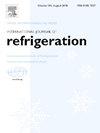燃气轮机的设计外建模集成与反布雷顿制冷循环为进口空气冷却
IF 3.8
2区 工程技术
Q1 ENGINEERING, MECHANICAL
International Journal of Refrigeration-revue Internationale Du Froid
Pub Date : 2025-09-30
DOI:10.1016/j.ijrefrig.2025.09.032
引用次数: 0
摘要
本研究开发并验证了一个非设计仿真框架,该框架用于集成了用于进口空气冷却的逆布雷顿制冷循环(RBC)的燃气轮机。压缩空气从中间压缩机级提取并在膨胀前冷却,以预冷却燃气轮机进口气流,该模型考虑了非设计压缩机性能,环境条件,湿度和潜热效应。对公布数据的验证表明,压缩机相对功率输出和相对热量输出在不同的萃取比上接近一致。结果表明,将RBC与燃气轮机动力循环相结合可以显著提高燃气轮机在温暖和潮湿条件下的性能特征。制冷量随着环境温度的升高而增加,在高湿度条件下,与低温条件相比,制冷量增加了50%以上。效率的提高也随着温度的升高而增加,在湿热条件下,冷却和非冷却循环之间的差异可达30%。优化的抽气压力比(πext≈3)和调整的抽气比(ER≈0.25 ~ 0.5)在平衡压缩机工作的同时提供了充分的冷却,从而降低了比油耗。净功率输出同样受益于RBC集成,相对增益随着环境温度和湿度的增加而增加,在极端气候条件下可达到40%以上。这些趋势突出表明,高温和高湿的综合影响放大了冷却需求,使进口空气冷却越来越有利。总体而言,该研究证实,仔细调整提取参数可以大幅提高冷却能力、循环效率和净功率输出,为在具有挑战性的环境中优化rbc -燃气轮机集成提供了一个经过验证的框架。本文章由计算机程序翻译,如有差异,请以英文原文为准。
Off-design modeling of gas turbines integrated with reverse Brayton refrigeration cycle for inlet air cooling
This study develops and validates an off-design simulation framework for a gas turbine integrated with a reverse Brayton refrigeration cycle (RBC) for inlet air cooling. Compressed air is extracted from intermediate compressor stages and cooled before expansion to pre-cool the gas turbine inlet air stream, with the model accounting for off-design compressor performance, ambient conditions, humidity, and latent heat effects. Validation against published data shows close agreement in compressor relative power output and relative heat output across varying extraction ratios. Results demonstrate that integrating the RBC with the gas turbine power cycle significantly enhances performance characteristics under warm and humid conditions. Cooling capacity consistently increases with ambient temperature, rising by over 50% at high humidity levels compared with low-temperature conditions. Efficiency improvements also grow with temperature, with the divergence between cooled and uncooled cycles reaching up to 30% under hot and humid conditions. Optimal extraction pressure ratios (πext ≈ 3) and tuned extraction ratios (ER ≈ 0.25 to 0.5) provide sufficient cooling while balancing compressor work, resulting in reduced specific fuel consumption. Net power output similarly benefits from RBC integration, with relative gains increasing with ambient temperature and humidity, reaching improvements exceeding 40% under extreme climate conditions. These trends highlight that the combined effects of high temperature and humidity amplify cooling demands, making inlet air cooling increasingly advantageous. Overall, the study confirms that careful adjustment of extraction parameters enables substantial gains in cooling capacity, cycle efficiency, and net power output, providing a validated framework for optimizing RBC-gas turbine integration in challenging ambient environments.
求助全文
通过发布文献求助,成功后即可免费获取论文全文。
去求助
来源期刊
CiteScore
7.30
自引率
12.80%
发文量
363
审稿时长
3.7 months
期刊介绍:
The International Journal of Refrigeration is published for the International Institute of Refrigeration (IIR) by Elsevier. It is essential reading for all those wishing to keep abreast of research and industrial news in refrigeration, air conditioning and associated fields. This is particularly important in these times of rapid introduction of alternative refrigerants and the emergence of new technology. The journal has published special issues on alternative refrigerants and novel topics in the field of boiling, condensation, heat pumps, food refrigeration, carbon dioxide, ammonia, hydrocarbons, magnetic refrigeration at room temperature, sorptive cooling, phase change materials and slurries, ejector technology, compressors, and solar cooling.
As well as original research papers the International Journal of Refrigeration also includes review articles, papers presented at IIR conferences, short reports and letters describing preliminary results and experimental details, and letters to the Editor on recent areas of discussion and controversy. Other features include forthcoming events, conference reports and book reviews.
Papers are published in either English or French with the IIR news section in both languages.

 求助内容:
求助内容: 应助结果提醒方式:
应助结果提醒方式:


